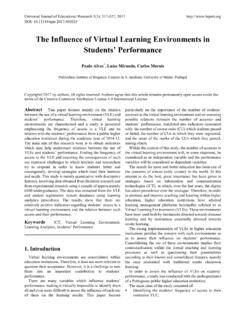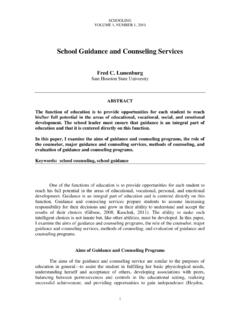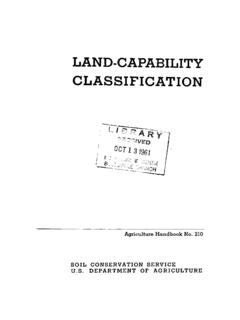Transcription of European Journal of Education Studies
1 European Journal of Education Studies ISSN: 2501 - 1111 ISSN-L: 2501 - 1111 Available on-line at: Copyright The Author(s). All Rights Reserved. 2015 2017 Open Access Publishing Group 369 doi: Volume 3 Issue 9 2017 STRENGTHS AND LIMITATIONS OF QUALITATIVE AND QUANTITATIVE RESEARCH METHODS Andr Queir s1, Daniel Faria1, Fernando Almeida2i 1 Higher Polytechnic Institute of Gaya, V. N. Gaia, Portugal 2 Faculty of Engineering of Oporto University, INESC TEC, Porto, Portugal Abstract: Scientific research adopts qualitative and quantitative methodologies in the modeling and analysis of numerous phenomena. The qualitative methodology intends to understand a complex reality and the meaning of actions in a given context.
2 On the other hand, the quantitative methodology seeks to obtain accurate and reliable measurements that allow a statistical analysis. Both methodologies offer a set of methods, potentialities and limitations that must be explored and known by researchers. This paper concisely maps a total of seven qualitative methods and five quantitative methods. A comparative analysis of the most relevant and adopted methods is done to understand the main strengths and limitations of them. Additionally, the work developed intends to be a fundamental reference for the accomplishment of a research study, in which the researcher intends to adopt a qualitative or quantitative methodology. Through the analysis of the advantages and disadvantages of each method, it becomes possible to formulate a more accurate, informed and complete choice.
3 Keywords: research methods, qualitative analysis, quantitative analysis, research process Andr Queir s, Daniel Faria, Fernando Almeida STRENGTHS AND LIMITATIONS OF QUALITATIVE AND QUANTITATIVE RESEARCH METHODS European Journal of Education Studies - Volume 3 Issue 9 2017 370 1. Introduction The scientific methodology is a tool of fundamental importance for the knowledge of the methods that are used in the elaboration of a scientific document, such as a manuscript, dissertation or a work of completing a university course. Scientific methodology includes the study of the methods or the instruments necessary for the elaboration of a scientific work. Flanagan (2013) claims that the scientific method is the most powerful tool for discovering truths about the world, explore new theories and perform their empirical validation.
4 Therefore, scientific research is the process of performing systematic and intensive inquisitions, which aims to discover and interpret the facts that are inserted in a certain reality. In relation to its approach, scientific research can be qualitative or quantitative. Qualitative research is not concerned with numerical representativity, but with the deepening of understanding a given problem. In qualitative research, the researcher is both the subject and the object of his research. The objective of the qualitative methodology is to produce in-depth and illustrative information in order to understand the various dimensions of the problem under analysis. Qualitative research is therefore concerned with aspects of reality that cannot be quantified, focusing on the understanding and explanation of the dynamics of social relations. Maxwell (2013) advocates that qualitative research works with the universe of meanings, motives, aspirations, beliefs, values and attitudes, which corresponds to a deeper space of relationships, processes and phenomena that cannot be reduced to the operationalization of variables.
5 On the other side, in quantitative research, the data can be quantified. Because the samples are generally large and considered representative of the population, the results are taken as if they constituted a general and sufficiently comprehensive view of the entire population (Martin & Bridgmon, 2012). Disciplines such as mathematics and statistics assume a fundamental importance in the process of analysis and generalization of the results obtained. Quantitative research focuses on objectivity and is especially appropriate when there is the possibility of collecting quantifiable measures of variables and inferences from samples of a population. Quantitative research adopts structured procedures and formal instruments for data collection. The data are collected objectively and systematically. Finally, the analysis of numerical data is performed through statistical procedures, often using software such as SPSS, R or Stata.
6 Table 1 summarizes the main differences between the quantitative and qualitative research methodology through looking for several dimensions, such Andr Queir s, Daniel Faria, Fernando Almeida STRENGTHS AND LIMITATIONS OF QUALITATIVE AND QUANTITATIVE RESEARCH METHODS European Journal of Education Studies - Volume 3 Issue 9 2017 371 Table 1: Differences between quantitative and qualitative research methodologies Dimension Quantitative research Qualitative research Focus on understanding the context of the problem Smaller Bigger Dimension of group Studies Smaller Bigger Proximity of the researcher to the problem being studied Smaller Bigger Scope of the study in time Immediate Longer range Researcher's point of view External Internal Theoretical framework and hypotheses Well structured Less structured Flexibility and exploratory analysis Lower Higher The study of the potentialities and weaknesses of the various research methodologies has been of interest to several researchers.
7 However, in practice, there are several difficulties in choosing the most appropriate research methodology and methods best suited to a given study. This work intends to give an important contribution in this decision process, through the systematic analysis of several research methods in order to emphasize its strengths and limitations. The paper is organized as follows: First, we perform a review of the state of the art in the field of qualitative and quantitative methodologies. Then, we present the adopted methodology, followed by the comparison of the most relevant advantages and disadvantages offered by each research method. Finally, we draw the conclusion of our work. 2. State of the Art There are several Studies that analyze generically the fundamental models of scientific research, in which qualitative and quantitative methodologies are used.
8 Atieno (2009) looks to the strengths and weaknesses of qualitative research and discusses how those limitations can be overcome by the option of quantitative research methods. Borrego et al. (2009) analyzes the presence of quantitative, qualitative and mixed research methods in engineering Education . They reach to the conclusion that there is a primacy by the adoption of quantitative methodologies, but they advocate that the choice must be driven by the research questions. Castellan (2010) uses two service-learning research projects to explain the differences between quantitative and qualitative research methodologies. Choy (2014) compares the strengths and weaknesses of qualitative and quantitative Studies . He reaches to the conclusion that both methodologies can be appropriate, but he advocates that a complementary approach between qualitative and quantitative approaches for a same research topic may provide better results than use only just one isolated methodology.
9 There are Studies that look in detail for several methods that can be used in qualitative research projects. Williams (2007) presents and discusses the potentialities Andr Queir s, Daniel Faria, Fernando Almeida STRENGTHS AND LIMITATIONS OF QUALITATIVE AND QUANTITATIVE RESEARCH METHODS European Journal of Education Studies - Volume 3 Issue 9 2017 372 and vulnerabilities of the three most common research approaches, qualitative, quantitative, and mixed methods. Baxter & Jack (2008) offer a concise guide targeted undergraduate students that identifies and summarizes the key elements for designing and implementing qualitative case study research projects. Roshan & Deeptee (2009) justify the increasing use of qualitative research methods due to their potentiality to explore several areas of human behavior that cannot be quantified.
10 Crescentini & Mainardi (2009) study the limitations of qualitative research articles in order to establish a set of guidelines that should be followed to increase the effectiveness of a research paper. The study concludes that the adoption of qualitative research techniques is not a handicap for publishing a research article. Then, the study identifies that the most important elements are: (i) well structured; (ii) transparent adoption of the research process; and (iii) easily understood by readers. Starman (2013) presents a full description of the case study methodology. He gives a detailed description of its definition, some classifications, and several advantages and disadvantages. Oppong (2013) analyzes the sampling issues in qualitative research in order to ensure that the sample size of a given study is adequate or representative.







